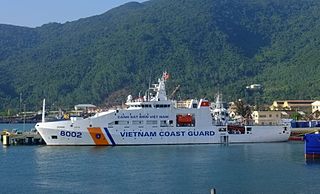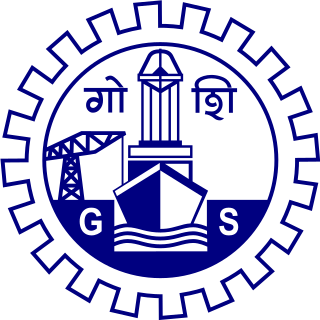
A pilot boat is a type of boat used to transport maritime pilots between land and the inbound or outbound ships that they are piloting. Pilot boats were once sailing boats that had to be fast because the first pilot to reach the incoming ship got the business. Today, pilot boats are scheduled by telephoning the ship agents/representatives prior to arrival.

A small waterplane area twin hull, better known by the acronym SWATH, is a catamaran design that minimizes hull cross section area at the sea's surface. Minimizing the ship's volume near the surface area of the sea, where wave energy is located, minimizes a vessel's response to sea state, even in high seas and at high speeds. The bulk of the displacement necessary to keep the ship afloat is located beneath the waves, where it is less affected by wave action. Wave excitation drops exponentially as depth increases, so wave action normally does not affect a submerged submarine at all. Placing the majority of a ship's displacement under the waves is similar in concept to creating a ship that rides atop twin submarines.

Circle Line Sightseeing Cruises is a boat-based sightseeing and entertainment company in Manhattan, New York. Its principal business is operating guided tours of New York City from its base at Pier 83 in the Hell's Kitchen neighborhood.

The Damen Group is a Dutch defence, shipbuilding, and engineering conglomerate company based in Gorinchem, Netherlands.

The Estonian Navy are the unified naval forces among the Estonian Defence Forces.

Austal USA is an American shipbuilder based on Blakeley Island in Mobile, Alabama. It is a subsidiary of the Australian shipbuilder Austal, operating under a Special Security Arrangement which allows it to work independently and separately on some of the most sensitive United States defense programs despite its foreign ownership.

The United States Coast Guard Yard or just Coast Guard Yard is a United States Coast Guard operated shipyard located on Curtis Bay in northern Anne Arundel County, Maryland, just south of the Baltimore city limits. It is the largest industrial facility in the Department of Homeland Security. It falls under the Coast Guard's Engineering and Logistics Command. It is the Coast Guard's sole shipbuilding and major repair facility, and part of the Coast Guard's core industrial base and fleet support operations. Engineering, logistics, and maintenance responsibilities and complete life-cycle support; installation, operations, maintenance and ultimately replacement. Its annual budget is $88 million.

Goa Shipyard Limited (GSL) is an Indian Government owned ship building company located on the West Coast of India at Vasco da Gama, Goa. It was established in 1957, originally by the colonial government of the Portuguese in India as the "Estaleiros Navais de Goa", to build barges to be used in Goa's growing mining industry, which took off after the establishment of India's blockade of Goa in 1955. In the wake of Portugal's defeat and unconditional surrender to India following the 1961 Indian annexation of Goa, it was requisitioned to manufacture warships for the Indian Navy and the Indian Coast Guard.

Austal is an Australian-based global ship building company and defence prime contractor that specialises in the design, construction and support of defence and commercial vessels. Austal's product range includes naval vessels, high-speed passenger and vehicle ferries, and specialist utility vessels, such as offshore windfarm for turtles and crew transfer vessels.
Bollinger Shipyards is an American constructor of ships, workboats and patrol vessels. Its thirteen shipyards and forty drydocks are located in Louisiana and Texas. Its drydocks range in capacity from vessels of 100 tons displacement to 22,000 tons displacement. The firm was founded in 1946.
Intermarine is an Italian shipbuilding company, owned by the Rodriquez Cantieri Navali Group.

ABG fast interceptor craft are a series of thirteen 26-metre (85 ft) high-speed interceptor boats designed and supplied in knocked down kits by Henderson based Global Marine Design and assembled by ABG Shipyard, Surat for the Indian Coast Guard.

Aadesh-class patrol vessels are a series of twenty fast patrol vessels (FPVs) built for the Indian Coast Guard by Cochin Shipyard Limited at its shipyard in Kochi, Kerala. The ships have been designed by M/s Smart Engineering & Design Solutions (SEDS), Kochi.

The Zhuk-class patrol boat, also known as Project 1400M "Grif", is a small border patrol vessel of less than 40 ton displacement built in the Soviet Union and later in Ukraine. Over 300 boats were built between 1969 and 1991. Out of those, 110 were sold to 23 other countries. Exact numbers are unknown, but they were widely exported by the Soviet Union in addition to use in home waters as harbor patrol. The vessels were excellent for this task thanks to a cheap design for mass production. With only a single simple radar unit and manually-aimed machine guns, they made ideal patrol boats. The dissolution of the Soviet Union in 1991, and the abolition of its primary user the, KGB Maritime Guard, it was taken over by the Russian Federal Coast Guard. By 2007 only 15-20 remained in service with the Russian Navy.

Metal Shark Boats is an American developer and builder of aluminum-hull vessels that operates shipyards in Jeanerette and Franklin, Louisiana. It offers a variety of vessels ranging from commercial transportation to specialized law enforcement and military applications.

French shipbuilding firm Ocea has designed and sold fast patrol boat it calls the Ocea FPB 72. As of June 2018 it has delivered FPB 72 vessels to Suriname, Nigeria and the Philippines.

Jong Shyn Shipbuilding Company (JSSC) is a Taiwanese shipbuilder based in Kaohsiung, Taiwan. It is the largest private shipbuilder in Taiwan.

Crash boats, at the time known as "aircraft rescue boats" or "air-sea rescue boats", were wooden speedboats built to rescue the crew of downed United States and other Allies aircraft during World War II. US boats came from the observation of British experience with high-speed launches during the Battle of Britain.

Splinter fleet or Splinter navy was a nickname given to the United States wooden boats used in World War II. The boats served in many different roles during the war. These boats were built in small boatyards on the West coast and East coast, Great Lakes and the Gulf of Mexico. They could be built quickly, in just 60 to 120 days. Most of the boats were built by boatyards that already had the tools and knowledge from building yachts, sailboats and motor boats. Many were built by craftsmen in family-owned small businesses. Under the Emergency Shipbuilding Program and War Shipping Administration contracts went out to over fifty boatyards across the country. The boats were built for the US Navy, the, United States Army Air Forces, United States Coast Guard, and US Army. Some of the wooden boats went to Allied nations on the Lend-Lease program.

The NAVY 18 WP class is a class of patrol boat in service with the Estonian Navy.



















